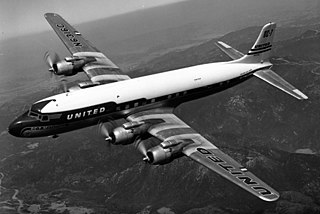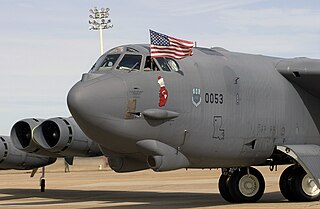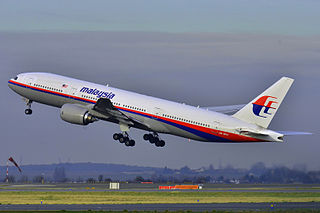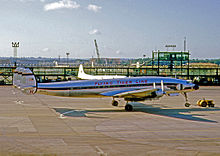
The Bermuda Triangle, also known as the Devil's Triangle, is an urban legend focused on a loosely defined region in the western part of the North Atlantic Ocean where a number of aircraft and ships are said to have disappeared under mysterious circumstances. The idea of the area as uniquely prone to disappearances arose in the mid-20th century, but most reputable sources dismiss the idea that there is any mystery.

The Douglas DC-7 is an American transport aircraft built by the Douglas Aircraft Company from 1953 to 1958. A derivative of the DC-6, it was the last major piston engine-powered transport made by Douglas, being developed shortly after the earliest jet airliner—the de Havilland Comet—entered service and only a few years before the jet-powered Douglas DC-8 first flew in 1958. Larger numbers of both DC-7B and DC-7C variants were also built.

American Airlines Flight 1 was a regularly scheduled passenger flight from New York International (Idlewild) Airport in New York City to Los Angeles International Airport in Los Angeles. During the March 1, 1962, operation of the flight, the Boeing 707 executing it rolled over and crashed into Jamaica Bay in New York City two minutes after taking off, killing all 87 passengers and eight crew members aboard. A Civil Aeronautics Board investigation determined that a manufacturing defect in the autopilot system led to an uncommanded rudder control system input, causing the accident. A number of notable people died in the crash. It was the fifth fatal Boeing 707 accident, and at the time, the deadliest. It was third of three fatal crashes during an operation of American Airlines Flight 1. Finally, this was the third fatal crash involving one of American's 707s in the New York area within a three-year period, after Flight 514 and Flight 1502.

Eastern Air Lines Flight 663 was a domestic passenger flight from Boston, Massachusetts, to Atlanta, Georgia, with scheduled stopovers at John F. Kennedy International Airport, New York; Richmond, Virginia; Charlotte, North Carolina; and Greenville, South Carolina. On the night of February 8, 1965, the aircraft serving the flight, a Douglas DC-7, crashed near Jones Beach State Park, New York, just after taking off from JFK Airport. All 79 passengers and five crew aboard died.

United Air Lines Flight 409 was a scheduled flight which originated in New York City, New York. The final flight destination was San Francisco, California, with stops in Chicago, Denver and Salt Lake City. The aircraft operating the service, a Douglas DC-4 propliner, registration N30062, crashed into Medicine Bow Peak, near Laramie, Wyoming, on October 6, 1955, killing all 66 people on board. The victims included five female members of the Mormon Tabernacle Choir and military personnel. At the time, this was the deadliest airline crash in the history of American commercial aviation. Another 66 lives had been lost earlier that year in the March 22 crash in Hawaii of a United States Navy Douglas R6D-1 Liftmaster military transport aircraft, and 66 had also died in the mid-air collision of two United States Air Force C-119G Flying Boxcars over West Germany on August 11, placing the three crashes in a three-way tie as the deadliest aviation incidents in 1955.

Flying Tiger Line Flight 282 refers to the crash of a Lockheed Super Constellation aircraft, N6915C, shortly after takeoff from San Francisco International Airport in the early morning hours of Thursday, December 24, 1964. There were 3 crewmen aboard: pilot Jabez A. Richards, 49, of Bayhead, New Jersey; Daniel W. Hennessy, 33, of Hillsborough, California, as co-pilot, and Paul M. Entz, 37, of North Hollywood, California, as flight engineer.
A government contract flight is a type of charter airline operation contracted with a government agency.

Eastern Air Lines Flight 537, registration N88727, was a Douglas DC-4 aircraft en route from Boston, Massachusetts, to Washington, D.C., via intermediate points on November 1, 1949. NX-26927 was a Lockheed P-38 Lightning being test-flown for acceptance by the government of Bolivia by Erick Rios Bridoux of the Bolivian Air Force. The two aircraft collided in mid-air at an altitude of 300 feet about half a mile southwest of the threshold of Runway 3 at Washington National Airport, killing all 55 aboard the DC-4 and seriously injuring the pilot of the P-38. At the time it was the deadliest airliner incident in United States history.

Cubana de Aviación Flight 493, registration CU-T188, was a Douglas DC-4 en route from Miami, Florida, to Havana, Cuba, on April 25, 1951. A US Navy Beechcraft SNB-1 Kansan, BuNo 39939, was on an instrument training flight in the vicinity of Naval Air Station Key West, Florida, at the same time. The two aircraft collided in mid-air over Key West, killing all 43 aboard both aircraft.

The Grand Canyon mid-air collision occurred in the western United States on June 30, 1956, when a United Airlines Douglas DC-7 struck a Trans World Airlines Lockheed L-1049 Super Constellation over Grand Canyon National Park, Arizona. The first one fell into a canyon and the other one slammed into a rock face. All 128 on board both airplanes perished, making it the first commercial airline incident to exceed one hundred fatalities. The airplanes had departed Los Angeles International Airport minutes apart from each other and headed for Chicago and Kansas City, respectively. The collision took place in uncontrolled airspace, where it was the pilots' responsibility to maintain separation. This highlighted the antiquated state of air traffic control, which became the focus of major aviation reforms.

Pan Am Flight 7 was a westbound round-the-world flight operated by Pan American World Airways. On November 8, 1957, the Boeing 377 Stratocruiser 10-29 serving the flight, named Clipper Romance of the Skies, crashed in the Pacific Ocean en route to Honolulu International Airport from San Francisco. The crash killed all 36 passengers and eight crew members.
Transocean Air Lines was an airline based in the United States that operated from 1946, when it was established as ONAT (Orvis Nelson Air Transport Company), until its bankruptcy in 1960. It was based in Oakland, California.

The 2008 Guam B-52 crash was a fatal crash of a United States Air Force (USAF) B-52H Stratofortress on 21 July 2008. The aircraft, operating out of Andersen Air Force Base, crashed into the Pacific Ocean during a training flight approximately 30 nautical miles (56 km) northwest of Apra Harbor, Guam. The training flight was to include participation in a local municipal celebration of Liberation Day in Hagåtña. All six crew members aboard the aircraft were killed and the aircraft was destroyed.

TWA Flight 529 was a Lockheed Constellation L-049 propliner, registration N86511, operating as a scheduled passenger service from Boston, Massachusetts to San Francisco, California. On September 1, 1961, at 02:05 CDT, the flight crashed shortly after takeoff from Midway Airport in Chicago, killing all 73 passengers and five crew on board; it was at the time the deadliest single plane disaster in U.S. history.

American Airlines Flight 28 was a scheduled domestic passenger flight that crashed on October 23, 1942, in Chino Canyon near Palm Springs, California, United States, after being struck by a United States Army Air Forces B-34 bomber. The B-34 suffered only minor damage, and landed safely at the Army Airport of the Sixth Ferrying Command, Palm Springs.

United Air Lines Flight 736 was a scheduled transcontinental passenger service flown daily by United Airlines between Los Angeles and New York City. On April 21, 1958, the airliner assigned to the flight, a Douglas DC-7 with 47 on board, was flying over Clark County, Nevada in clear weather when it was involved in a daytime mid-air collision with a United States Air Force fighter jet crewed by two pilots. Both aircraft fell out of control from 21,000 feet (6,400 m) and crashed into unpopulated desert terrain southwest of Las Vegas, leaving no survivors. The loss of Flight 736, one of a series of 1950s mid-air collisions involving passenger aircraft in American skies, helped usher-in widespread improvements in air traffic control within the United States, and led to a sweeping reorganization of federal government aviation authorities.

Hawaii Clipper was one of three Pan American Airways Martin M-130 flying boats. It disappeared with six passengers and nine crew en route from Guam to Manila, on July 28, 1938.

On July 12, 1953, Transocean Air Lines Flight 512, a Douglas DC-6A operated by Transocean Air Lines from Guam to Oakland, California, crashed into the Pacific Ocean roughly 630 km (340 nmi) east of Wake Island while en route to Honolulu for a planned stopover. All 58 passengers and crew on board were killed.

Malaysia Airlines Flight 370 (MH370/MAS370) was an international passenger flight operated by Malaysia Airlines that disappeared from radar on 8 March 2014, while flying from Kuala Lumpur International Airport in Malaysia to its planned destination, Beijing Capital International Airport in China. It has not been determined what caused her disappearance.

The 1973 Nantes mid-air collision occurred when two airliners travelling to London Heathrow airport hit each other over Nantes, France, on 5 March 1973. They were an Iberia McDonnell Douglas DC-9 flying from Palma de Mallorca to London and a Spantax Convair 990 from Madrid to London. All 68 people on board the DC-9 were killed. The CV-990 was able to make a successful emergency landing at Cognac – Châteaubernard Air Base.


















